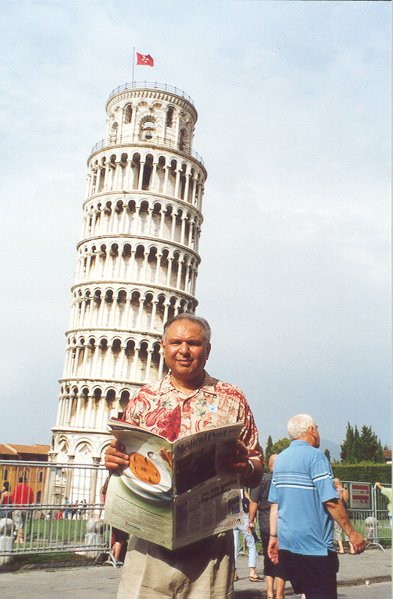There’s more than one way to see beautiful Alaska – and you don’t have to stick to just one.
I had been dreaming of an Alaskan cruise for a long time. Now that our children are a little older – Alia is 10 years old and Hussein is 12 – my wife Sabiya and I felt this was the best time to make this once in a lifetime trip.
I knew I wouldn’t be the first to travel to Alaska, of course – in 1725, a Russian explorer, Vitus Bering, became the first European to set foot on Alaskan soil. Since then much has changed.
In 1867, U.S. Secretary of State William Seward purchased Alaska from Russia for two cents an acre! Critics laughed and called it foolish. But soon Alaska surprised the world with its wealth of natural resources (gold, oil, tourism, fishing and lumber).
Alaska is the largest state in the U.S. It is 2.5 times the size of Texas, with a population of only 609,300.
Our cruise on the Norwegian Wind began on a Monday evening in Vancouver.
We boarded the 50,000-ton ship with significantly less fanfare than was seen during the departure scene in the movie Titanic. From the deck, we took pictures of a breathtaking Vancouver sunset as we headed out of the harbour.
Next it was time to explore the ship, which is really more of a floating city. It had everything we’d ever want in a week!
The cabins were cleaned twice a day (including changing of towels) and there was plenty of food – certainly enough for the 2,000 passengers and 625 crew members to last for more than a week. Food services started at 6 a.m. and ended with the midnight buffet.
Nor were all of the snacks necessarily “unhealthy.” Besides fresh fruits and vegetables, there are sugarless desserts and low-calorie items on the menu.
One thing they don¼t provide is the willpower to say no¾ to unhealthy foods!
For fitness buffs, there was a fully-equipped gym with massage therapists. Many varieties of fitness classes were offered that range from beginners to advanced levels. Sauna, spa, aerobics, yogaãyou name it and they had it. There was a basketball area, a small driving range (with lousy clubs), table tennis, two small swimming pools, two hot tubs and walking and jogging areas.
Evening was a time for laughter and fun. There were outstanding Broadway-style shows, stand-up comedians and singers. The audience participation events were especially fun.
The ship offered babysitting arrangements, children’s programs and teen activities.
For gamblers, there was daily lotto, bingo and a casino.
There were two formal evenings when we dressed up in our best clothes. There was a beauty salon, and we could even have rented a tuxedo!
But of course, the strongest draw of cruising the Inside Passage is to be on deck, enjoying the open sea, fresh air, sunshine and blue skies (if it does not rain – this is, of course, the West Coast). Evenings on deck are majestic, calm and relaxing as one watches other beautifully lit cruise ships periodically sailing by.
The ship’s first stop was Juneau, Alaska’s capital city with a population of 26,800 which is inaccessible by road. Mountains, islands, saltwater bays, forested valleys and flatlands surround it.
With the few hours we had in Juneau, we had to decide whether we should go sea kayaking, canoeing, hiking, flying over a glacier by helicopter, panning for gold, sportfishing or to a salmon bake.
Our children decided we’d go glacier trekking by helicopter. Luckily, I had my plastic card as some of the on-shore options have a separate fee. The helicopter soared over Juneau’s wild backcountry and spectacular glaciers, covering 65 miles of Alaskan wilderness and making a brief glacier landing within the massive Juneau ice field. The view was spectacular.
Our pilot/guide showed us a bit of the beauty and mystery of the area by walking us through some interesting spots which require special boots. Juneau ice field is North America’s fifth largest ice field. It covers more than 1,500 square miles of land. The ice field¼s snow and ice depth are estimated to be from 800 to more than 4,500 feet deep. Annual snowfall on the Juneau ice field exceeds 100 feet.
During the flight, we caught tantalizing glimpses of mountain goats. The goats favour the high ridges surrounding the ice field during the summer months.
Then, too quickly, it was time to board the ship again. In the next couple of days, we disembark at Skagway (population 700), Haines (population 1,200), and Ketchikan (population 8,300).
Each has its own history and beauty. But there is something special about Skagway and its 100-year-old connection to the Klondike Gold Rush.
In Skagway, for our off-ship adventure, we took a trip on the White Pass Scenic Railway and saw some of the most spectacular scenery we’d ever hope to see. The train (some train cars are straight out of the 1890s) leaves Skagway (elevation: 0) on a narrow-gauge railroad (built 1898), climbs through the coast mountains in Tongass National Forest and through mountain tunnels to the White Pass Summit (elevation: 2,865 ft).
The last of the spectacular scenery before heading back to Canada was Glacier Bay. Naturalist and adventurer John Muir is credited with discovering the bay in 1879 but it continues to remain isolated and undeveloped. We entered Glacier Bay and cruised along shorelines covered by ice. As water undermines some ice fronts, great blocks of ice break loose and crash into the water. It was a beautiful sight to cherish.
Then it was time to cruise back to Vancouver and the real world. In the end, it was an unforgettable experience.
Start reading the preview of my book A Doctor's Journey for free on Amazon. Available on Kindle for $2.99!
